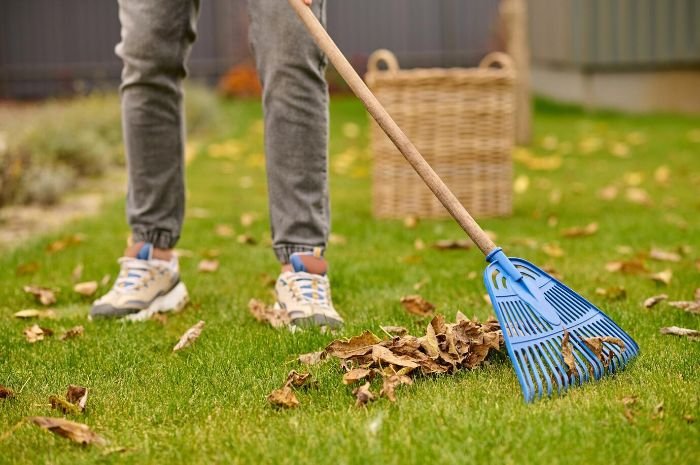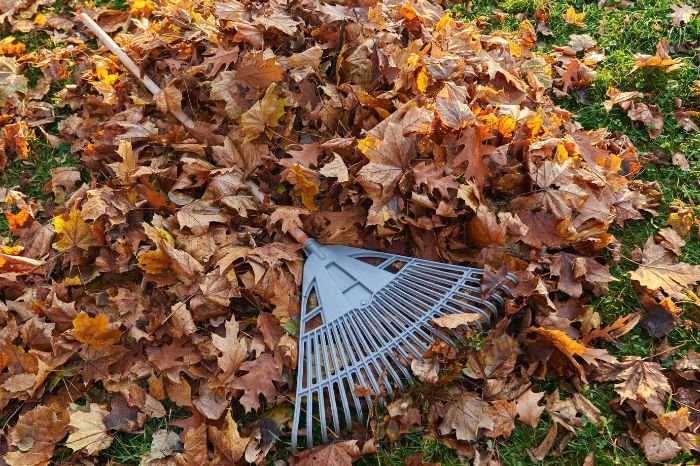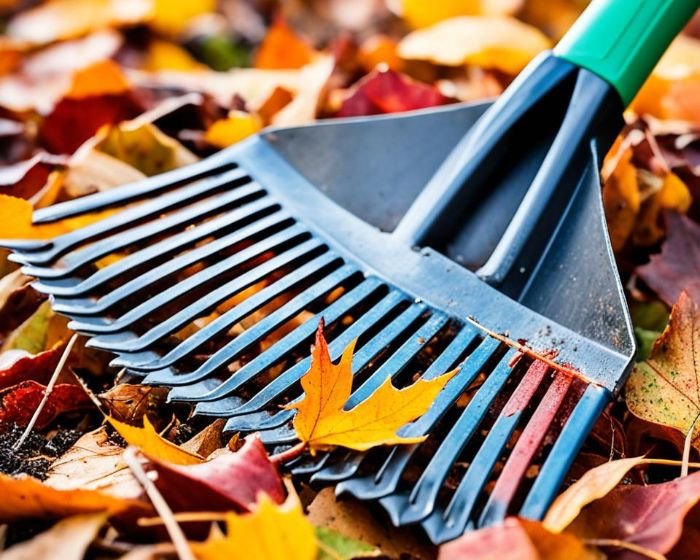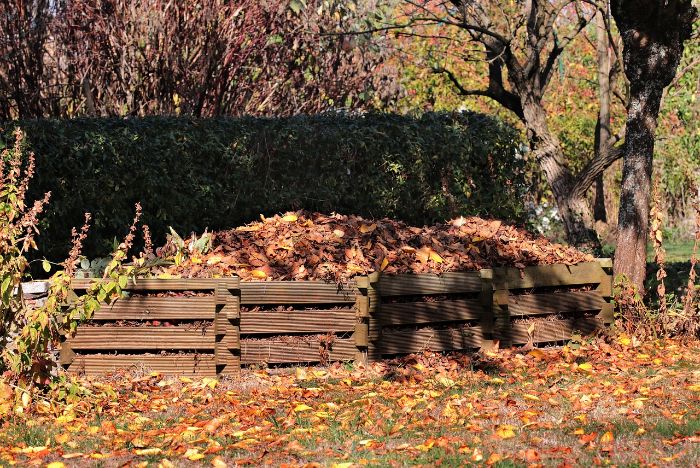As autumn begins, homeowners find themselves dealing with fallen leaves. Collecting leaves properly is key for a clean yard and healthy lawn. This article shares expert tips for smart leaf collection. It covers picking the right leaf rake, common challenges, and how to rake leaves better.
Key Takeaways:
- Proper leaf collection ensures a tidy yard and promotes the health of your lawn and garden.
- Choosing the right leaf rake is crucial for efficient leaf collection.
- There are various challenges associated with leaf collection, such as dealing with large or wet leaves.
- Maximizing leaf rake efficiency can save you time and effort.
- Environmental considerations, such as composting leaves, are important for responsible leaf disposal.
Table of Contents
Introduction to Efficient Leaf Collection
Keeping your yard clean is important. Choosing the right leaf rake can make this task easier. It helps you pick up leaves quicker and save time. Also, knowing about the difficulties, like dealing with big or wet leaves, prepares you better.
The Importance of Choosing the Right Leaf Rake
Picking the correct leaf rake is key for quick leaf collection. A rake with strong teeth makes getting leaves off the ground simpler. Look for one with a user-friendly handle to avoid discomfort. A quality rake is a good investment for effective leaf collection.
Overview of Leaf Collection Challenges
There are some difficulties in gathering leaves. Large or wet leaves are harder to rake up. They are heavy and clump together. A suitable leaf rake can face these issues well. Also, working around flower beds and trees needs careful work. Knowing these challenges helps in coming up with ways to deal with them.
Selecting the Right Leaf Rake for Your Needs
Finding the right leaf rake is important for easy and efficient leaf collection. The best rake for you can change how well you pick up leaves. But, how can you pick the perfect one with so many choices?

Key Features to Look for in a Leaf Rake
There are some important things to check when you’re picking out a leaf rake:
- Pick a rake head that’s big enough to clean large areas quickly. It should also be strong to handle lots of leaves.
- Choose a rake handle that’s long for easy reach and made from light, yet tough materials.
- Look for a rake that’s not too heavy for easy use, but still strong for many seasons.
Comparing Different Types of Leaf Rakes for Specific Tasks
There are many types of leaf rakes, each for a different job:
- Traditional leaf rakes have flexible tines and work well for most tasks.
- Adjustable rakes let you change their width and are good for various parts of your yard.
- Ergonomic rakes are designed to be easier on your hands and back, great for those who collect leaves often.
Think about what you need and the size of your yard when you pick a leaf rake. Choosing the right one will help you collect leaves much better.
Techniques for Effective Leaf Raking
Learning how to rake leaves well is key for a simple and quick leaf clean-up. Stick to the best methods and use tools that keep your body safe and make you work better. This helps you avoid hurting yourself while being super productive. Now, let’s dig into these helpful methods.
Best Practices for Raking Leaves
At first glance, raking leaves seems easy, but knowing the right way makes a big difference. Start by working in small parts of your yard, not all at once. This makes it easier to control and ensures you’ll clear all the leaves.
Use your body correctly to avoid hurting yourself. Bend your knees slightly and use your leg power when you pull the rake. This way, you protect your back. And try to keep a steady speed. This helps you work better. But don’t forget to take short rests if you’re tired.
Ergonomic Techniques to Prevent Strain
Raking leaves can stress your body, especially if it’s a long job. Use tools and techniques that lessen this strain and lower injury chances. Pick a rake that feels easy on your hands. Think about getting one with a handle you can change to fit your height. This will also help your back.
Swap your rake’s side to side while you work to share the effort with both hands. And pause to stretch often. This keeps your muscles and joints from getting too tight.
Maximizing Leaf Rake Efficiency
To collect leaves more effectively, try some tips and tricks. By using these methods, you can speed up and improve your leaf gathering. This means you’ll make the most of your leaf rake time.
Tips for Speeding Up Your Leaf Collection
- Rake in the right direction – Always rake leaves towards you or the wind. This stops leaves from flying back onto places you’ve already cleaned. You’ll work better this way.
- Utilize efficient movement patterns – Don’t just rake randomly. Work in a clear pattern, going from one yard corner to the opposite. Don’t miss any spots and avoid going over the same place twice.
- Use your body efficiently – Be careful about how you’re moving when you rake. Don’t bend or twist too much. Use your legs and core to do the hard work. Take breaks to stay in good shape.
- Get into a rhythm – Find a steady rhythm for raking leaves. This keeps you going without tiring too quickly. Take short rests but keep up the good work.
Tools and Accessories to Enhance Rake Performance
Adding certain tools to your leaf rake can also boost its performance. These tools make it easier to gather and get rid of leaves.
- Leaf bags – Use strong, large leaf bags to gather more leaves at once. This will cut down on how many trips you take.
- Tarps – Put down a tarp for an easy leaf collection spot. Rake leaves onto the tarp. Then, simply pick up the tarp’s corners to move the leaves all at once.
- Leaf scoops – These can make collecting and bagging leaves easier. They’re like big hands to help you work faster and with less effort.
By adding these tips and tools to your leaf rake routine, you’ll make the whole process smoother and faster.
Maintenance and Care of Leaf Rakes
Taking care of your leaf rake helps it last longer and work better. You can do this by cleaning and storing it well. We’ll show you how to do this. Plus, we’ll talk about when you need a new leaf rake and how to see if yours is worn out.
Proper Cleaning and Storage Solutions
Clean your leaf rake after you use it. Take off any leaves or debris with a garden hose or a brush. Check for any bent or broken tines and fix them if you find any. For tough dirt or sap, a mild soap or detergent can help. After cleaning, let the rake dry completely before you put it away.
For storage, pick a dry place like a shed or garage. Make sure it’s not too hot or too wet. You can hang your rake up to keep it safe and ready for use. Or, you can lay it down with the tines up. To avoid rust, you can also put a protective spray on the tines.
When to Replace Your Leaf Rake
Sometimes, even with care, your rake might need replacing. Tines can wear out or break, making the rake less effective. If the tines move a lot or are wobbly, it’s probably time for a new rake. The handle cracking or feeling weak also means it’s time for a new one.
If you have more leaves to rake, you might need a better rake. There are many types to choose from. Some have long handles you can adjust. Others are made for more comfort when you’re gathering leaves.
Advanced Leaf Collection Strategies
Advanced leaf collecting has new and better ways to get the job done. Let’s look at methods that are more than just raking. These ways are great for collecting a lot of leaves at one time.
Using Leaf Rakes in Combination with Other Yard Tools
Mixing leaf rakes with other tools helps a lot. Using a leaf blower or vacuum along with a rake works well. First, blow or vacuum leaves to one spot. Then, use the rake to make piles. This combo makes things quicker and easier, especially in big areas or with lots of leaves.

Innovative Methods for Large-Scale Leaf Management
For collecting lots of leaves, try out some new methods. Using leaf tarps or large sheets can simplify the process. Put the tarp down, rake leaves onto it, then bundle up the leaves in it. This makes moving a big number of leaves easier.
Storing leaves for compost is another smart idea. Instead of throwing them away, use them to make garden compost. Put leaves in a bin and turn them over sometimes to help them break down. In a few months, you’ll have great compost for your plants.
These advanced ways of collecting leaves, like using new tools and large-scale techniques, can make the job easier. They help improve how you handle and collect leaves.
Environmental Considerations and Leaf Disposal
Being a responsible homeowner means we need to focus on eco-friendly leaf disposal. This helps lower our impact on the environment. Rather than just tossing them away, we can explore green options.
Eco-Friendly Disposal of Collected Leaves
The best way to dispose of leaves is to turn them into compost. This method makes use of leaves in a way that benefits the earth. Composting turns leaves into rich soil boosters for your garden. It cuts down on waste and helps plants grow naturally.
For effective leaf composting, put them in a compost bin or pile. Mix in green materials like grass clippings, and brown materials like leaves. Turn the compost heap often to help it break down. Make sure it stays moist. Soon, you’ll have perfect compost to feed your plants.
Composting Leaves for Garden Use
Composting leaves isn’t just good for the environment; it’s good for your garden too. The compost you create will improve your soil. It will help the soil hold onto water better and feed your plants more efficiently. Spread the compost on your garden or around your plants.
But, don’t compost leaves with pesticides or diseases. To keep your garden safe, only compost leaves from healthy plants. This avoids spreading harmful bugs or diseases.
FAQ
How do I choose the right leaf rake?
When picking a leaf rake, think about the head size and material. Also, consider the handle’s length and what it’s made of. Look at the rake’s weight, how tough it is, and what you need it for. You might want a traditional, adjustable, or ergonomic rake.
What are the best practices for raking leaves?
Rake leaves in small areas using the right body movements. Keeping a good pace helps you finish faster and with less effort. To avoid hurting yourself, use ergonomic methods to lessen strain and prevent injuries.
How can I maximize the efficiency of my leaf rake?
For best leaf rake results, rake in the best way and use effective movements. This makes leaf gathering quicker and easier. Use tools like leaf bags, tarps, or scoops to work even better.
How should I maintain and care for my leaf rake?
Keep your leaf rake clean and stored well to make it last longer. This stops it from getting damaged and adds years to its life. Know when it’s time to get a new rake by watching for signs of wear and tear.
Are there any advanced strategies for leaf collection?
Enhance your leaf collection by mixing leaf rakes with other tools. Leaf blowers or vacuums can make the job quicker and simpler. Explore new ways like using leaf tarps or setting up leaf composting areas for big leaf piles.










